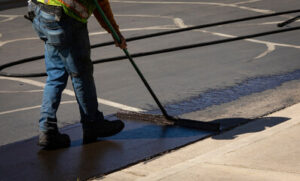Sealcoating is the process of layering a protective substance onto asphalt pavement. The resulting surface is protected against weathering, sun damage and oil spills.
It’s an inexpensive preventative maintenance strategy that can save you money in the long run by prolonging your blacktop driveway or parking lot. Visit https://www.rochesternysealcoating.com/ to learn more.

Asphalt is exposed to harsh elements like water, chemicals and abrasion from traffic. It also suffers from the sun’s UV rays, which can weaken it and make it dry and brittle. Sealcoating is a simple maintenance solution that protects your asphalt surface against these harmful substances and prolongs its life.
Aside from keeping your parking lot looking fresh and appealing, asphalt sealcoating provides a host of other benefits for you and the people who use it. It helps to prevent cracks from forming and the damage they can cause, as well as preventing moisture from damaging your pavement.
The first step in preparing your asphalt for sealcoating is cleaning the surface thoroughly. This includes removing any debris, filling cracks and addressing potholes. Once the surface is clean, workers can spray a layer of the sealant onto the pavement and spread it around with brushes or squeegees to ensure an even coat.
Once applied, sealcoating forms a thick layer over your parking lot, preventing water from entering the cracks in the asphalt and causing further damage. This also protects the asphalt from the evaporation of water during the hot weather, which can cause it to crack. Sealcoating also contains additives that help to slow down the oxidation of asphalt and keep it resilient and durable.
When water seeps through asphalt, it can erode the base, which leads to further cracking and structural failure. Sealcoating is designed to stop this from happening by forming a waterproof barrier, protecting the asphalt from the elements.
Another important function of sealcoating is to protect against oil and chemical spills. These substances can break down the binding agents in the asphalt, which can then lead to surface breakdown and failure. The additives in a quality sealcoat are resistant to these chemicals, allowing the asphalt to withstand spills and protect the underlying base. This extends the lifespan of your asphalt, saving you money in repairs and replacement costs. It also prevents your parking lot from becoming slick when wet, which can be dangerous for those who use it.
Prevents Water From Entering Cracks
A key component to a successful asphalt maintenance strategy is regularly applying sealcoat. This preventive measure is designed to shield asphalt from environmental damage and extend its lifespan. It’s also a cost-effective alternative to other forms of pavement repair and restoration, such as full parking lot resurfacing or asphalt patching.
Sealcoating also protects against water intrusion, a primary cause of cracking and further damage to asphalt. The application of a thick layer of sealer fills the small cracks that develop in asphalt, effectively creating a barrier to water penetration. It’s important to note that these cracks are not the same as the larger, deeper ones found in a damaged asphalt surface.
Before the sealant is applied, the pavement needs to be clean and dry. This is done by power washing or using industrial sweepers to ensure the surface is free from dirt, debris and other substances that may interfere with adhesion. In addition, it is a good idea to shut down any sprinkler systems that are near the pavement area during the time of application.
When a commercial property owner is planning to have a sealcoat applied, they should work with an experienced contractor that has the proper equipment and knowledge to effectively carry out this project. The contractor should be able to identify the best type of sealant to use, depending on the specific needs and environment of the asphalt surface. Additionally, the contractor should be able to evaluate the condition of the asphalt and offer insight into its future performance.
After the sealant is applied, the surface should be allowed to completely cure for about a day or two. This is to allow the sealant to adhere properly and create a solid bond with the surface beneath it. It is also important to keep vehicles off of the newly sealed surface for this period of time as well.
Sealcoating is an essential part of any business’s overall pavement maintenance plan. It acts as a protective shield that safeguards the surface from harsh UV rays, water problems and staining caused by oil. It also provides a smooth, dark appearance that enhances the curb appeal of your property.
Prevents Oil Spills
The primary function of sealcoating is to serve as a barrier, protecting asphalt surfaces from oil and chemical spills. These substances can penetrate unprotected pavement and degrade the underlying materials, which can be expensive to repair or replace. By preventing these chemicals from penetrating the surface, sealcoating protects pavement against damage and extends its lifespan.
Asphalt sealcoating is a proactive, cost-effective maintenance strategy that offers numerous benefits to property owners. By enhancing protection against environmental factors, preserving appearance and minimizing damage, this treatment can extend the lifespan of asphalt pavement by up to 100 percent and minimize long-term maintenance costs.
When properly administered, asphalt sealcoating also enhances curb appeal and adds a professional, well-maintained look to commercial driveways and parking lots. Regular sealcoating helps to maintain the original black color of the asphalt, thereby increasing its visual appeal and adding value to the property.
In addition, a fresh coat of asphalt sealcoat helps to protect the asphalt from harmful UV rays and water damage. It can also improve the texture of the pavement, making it easier to clean and more durable against the elements.
Sealcoating is typically performed from spring through fall. To ensure that the sealant dries and bonds correctly, it is important to keep people and vehicles off the asphalt until the surface has fully cured. This can be done by posting warning signs or blocking off the area with cones and barricades.
Before applying the sealant, the crew power washes the surface and treats any oil spots. Then, they spread a thick coating of the material with a broom or squeegee, working from multiple directions to ensure even coverage. After the sealant has dried, the crew squeegees again to remove any excess and make sure that there are no gaps or holes in the new coating.
Most sealcoating companies use water-based emulsions that are non-toxic and safer for the environment than traditional solvent-based products. They can reduce air pollution and greenhouse gas emissions during application, and they comply with environmental regulations and standards. This makes them a better choice for environmentally responsible property owners who want to limit their impact on the environment while maintaining their properties.
Protects Against Chemical Substances
Asphalt is known for its resilience and durability, but even this sturdy material eventually succumbs to the relentless onslaught of weather elements, harmful substances, and the rigors of everyday wear and tear. With sealcoating, you can safeguard your blacktop against these threats and extend its lifespan.
The protective mantle of sealcoating shields asphalt from the sun’s scathing UV rays and moisture that can wreak havoc on pavement. As a result, it prevents oxidation and deterioration, thereby minimizing the risk of cracking and pothole formation. It also helps thwart the intrusion of unwanted chemicals that eat away at the binder, including oil and salt.
In addition, the sealcoat enhances the appearance of your asphalt. The rich, ebony hue imparts a lustrous, well-maintained look to your parking lot or driveway that dramatically amplifies the curb appeal of your property.
As an added bonus, the protective layer of the sealcoat will reflect sunlight rather than absorb it, which will help melt snow and ice faster. This will allow you to remove these substances from your parking lot or driveway more quickly, saving you time and money.
Another important aspect of the sealcoating process is ensuring that the asphalt surface you’re sealing is free of debris and dirt. This is because the sealcoating product will bond more effectively to an already clean and dry surface. If you don’t thoroughly clean your pavement before applying the sealcoat, it may not adhere properly and could peel or crack later on.
Moreover, it’s essential to have your sealcoat applied by professional contractors that use the right equipment and materials for the job. They should also follow the manufacturer’s guidelines for temperature, humidity, and other factors that affect how the sealcoat is used. Furthermore, they should block off the area where the work will be done so that nothing gets in the way of the application and drying process. Lastly, it’s essential to have the sprinkler system turned off for at least 24 hours prior to and during the entire sealcoating process. If you’re interested in enhancing the appearance of your asphalt, consider hiring a professional Maryland sealcoating company to apply a fresh coat of protective sealer.








